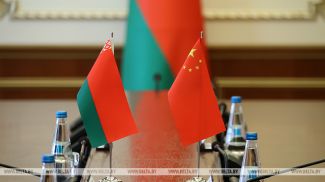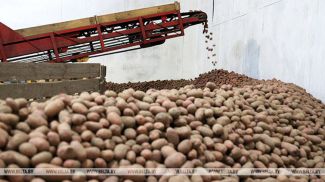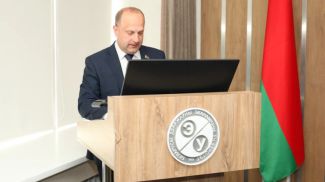MINSK, 16 April (BelTA) – The Belarusian holding company Belstankoinstrument plans to establish cooperation with Russian defense industries in equipment deliveries, Director General of the Belarusian holding company Belstankoinstrument Viktor Butko told BelTA.
“We have held a presentation of our capabilities for the Russian defense industry, in the Stankin Institute,” remarked Viktor Butko. “Our products can be in demand there. Moreover, we can use our designers, production engineers to team up with Russians to carry out the technical audit of enterprises for the sake of determining the state of equipment. We have also agreed that we will do this work at a Russian defense factory in the town of Safonovo, Smolensk Oblast”.
Belstankoinstrument has thoroughly examined the projects to develop the defense industry and the machine tool engineering industry of Russia. The Russian government has allocated RUB420 billion ($13.4 billion) for modernizing defense industries in 2012-2015. Meanwhile, at present Russia uses about 2.1 million units of metalworking equipment. About 75-80% of the total has been in use for 15-20 years, resulting in nearly 100% deterioration, with only 4.5% of the equipment used for less than five years. Therefore, the demand for new equipment is there and Belarusian machine tool manufacturers are ready to take part in joint projects with Russia, said Viktor Butko.
Moreover, Russia is the main strategic market for Belstankoinstrument enterprises, with 40-60% of the exports shipped there. Belarus is the monopolist in Russia for many kinds of the machine tools it manufactures. Such equipment is made by OAO StankoGomel (vertical planers and automatic straightening and cutting machines), OAO Vizas (tool grinding machinery, NC grinding machines, NC gear-grinding machines).
The Ukrainian market that has a sufficient industrial potential is of much interest for Belarusian manufacturers of machine tools. The machine tools are needed by the mining industry, transport industry, in particular, railways, by construction companies. The Kyiv-based joint venture BelUkrstankoinstrument has been set up to penetrate the market.
Negotiations and meetings have been held with representatives of Kazakhstan companies including TOO Signal Asia, OAO Kazakhmys, OAO ArcelorMittal, AO Vostokmashzavod (VMZ). Active discussions about possible joint projects are underway with representatives of companies from Egypt, Czechia, India, Slovenia, and Australia.
“We plan to start the joint assembly of equipment and modern instruments in Belarus together with internationally recognized machine tool manufacturers. This way we will make import substitutes with future localization of manufacturing,” stressed the Director General of the holding company. The Orsha-based machine tool company Krasny Borets started several projects for manufacturing cooperation with foreign partners in 2012. The projects will run till 2015.
Together with the Italian company EMCO Belstankoinstrument has mastered the production of five-axis vertical milling centers. There are plans to export the equipment to CIS and non-CIS states in the future.
Work continues to determine the advisability of starting the joint production of metal-cutting equipment together with the Israeli company ISCAR using premises of OAO Orsha Tool Factory.
Such kinds of manufacturing cooperation allow Belstankoinstrument enterprises to start manufacturing innovative products faster, substitute imports with further localization. “In the future it will allow offering new products on foreign markets and occupying a certain niche on the global market of metalworking equipment,” concluded Viktor Butko.
In Q1 2013 Belstankoinstrument enterprises exported $1.437 million worth of products, 16.3 times up from Q1 2012. In 2012 merchandise export was about $3 million. In 2013 the output is expected to be 108.5%, with the output at 109.6% in Q1 2013.
The holding company Belstankoinstrument was founded in July 2012. It comprises 16 enterprises of the Industry Ministry. They manufacture machine tools and instruments, various kinds of metalworking equipment. OAO MZOR is the management company. At present the holding company employs over 9,300 people.
“We have held a presentation of our capabilities for the Russian defense industry, in the Stankin Institute,” remarked Viktor Butko. “Our products can be in demand there. Moreover, we can use our designers, production engineers to team up with Russians to carry out the technical audit of enterprises for the sake of determining the state of equipment. We have also agreed that we will do this work at a Russian defense factory in the town of Safonovo, Smolensk Oblast”.
Belstankoinstrument has thoroughly examined the projects to develop the defense industry and the machine tool engineering industry of Russia. The Russian government has allocated RUB420 billion ($13.4 billion) for modernizing defense industries in 2012-2015. Meanwhile, at present Russia uses about 2.1 million units of metalworking equipment. About 75-80% of the total has been in use for 15-20 years, resulting in nearly 100% deterioration, with only 4.5% of the equipment used for less than five years. Therefore, the demand for new equipment is there and Belarusian machine tool manufacturers are ready to take part in joint projects with Russia, said Viktor Butko.
Moreover, Russia is the main strategic market for Belstankoinstrument enterprises, with 40-60% of the exports shipped there. Belarus is the monopolist in Russia for many kinds of the machine tools it manufactures. Such equipment is made by OAO StankoGomel (vertical planers and automatic straightening and cutting machines), OAO Vizas (tool grinding machinery, NC grinding machines, NC gear-grinding machines).
The Ukrainian market that has a sufficient industrial potential is of much interest for Belarusian manufacturers of machine tools. The machine tools are needed by the mining industry, transport industry, in particular, railways, by construction companies. The Kyiv-based joint venture BelUkrstankoinstrument has been set up to penetrate the market.
Negotiations and meetings have been held with representatives of Kazakhstan companies including TOO Signal Asia, OAO Kazakhmys, OAO ArcelorMittal, AO Vostokmashzavod (VMZ). Active discussions about possible joint projects are underway with representatives of companies from Egypt, Czechia, India, Slovenia, and Australia.
“We plan to start the joint assembly of equipment and modern instruments in Belarus together with internationally recognized machine tool manufacturers. This way we will make import substitutes with future localization of manufacturing,” stressed the Director General of the holding company. The Orsha-based machine tool company Krasny Borets started several projects for manufacturing cooperation with foreign partners in 2012. The projects will run till 2015.
Together with the Italian company EMCO Belstankoinstrument has mastered the production of five-axis vertical milling centers. There are plans to export the equipment to CIS and non-CIS states in the future.
Work continues to determine the advisability of starting the joint production of metal-cutting equipment together with the Israeli company ISCAR using premises of OAO Orsha Tool Factory.
Such kinds of manufacturing cooperation allow Belstankoinstrument enterprises to start manufacturing innovative products faster, substitute imports with further localization. “In the future it will allow offering new products on foreign markets and occupying a certain niche on the global market of metalworking equipment,” concluded Viktor Butko.
In Q1 2013 Belstankoinstrument enterprises exported $1.437 million worth of products, 16.3 times up from Q1 2012. In 2012 merchandise export was about $3 million. In 2013 the output is expected to be 108.5%, with the output at 109.6% in Q1 2013.
The holding company Belstankoinstrument was founded in July 2012. It comprises 16 enterprises of the Industry Ministry. They manufacture machine tools and instruments, various kinds of metalworking equipment. OAO MZOR is the management company. At present the holding company employs over 9,300 people.













